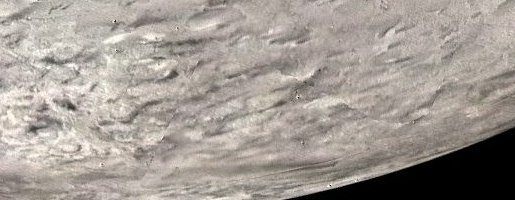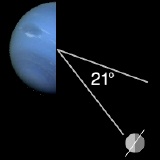 |
|
|
Wind
streaks and plumes characterise Triton's southern hemisphere.
|
|
| THE ATMOSPHERE OF TRITON | |
| Triton's very thin atmosphere consists mainly of nitrogen, with a trace amount (0.01%) of methane. The atmosphere of Triton regularly freezes out onto the surface - an unusual behavior for an atmosphere. Only three other Solar System bodies have atmospheres that behave in this manner - Io, Mars, and Pluto. | |
| The dark surface streaks and plumes visible against Triton's surface provide additional information concerning the atmosphere. The streaks tend to fan out towards the northeast, whereas plumes at higher altitudes seem to travel towards the west. This implies that the lower levels of the atmosphere have winds that blow to the northeast, at intermediate levels the winds are eastwards, and at a height of 8 kilometres winds are westwards. | |
| Temperatures | |
| Triton is the coldest body in the Solar System, colder even than Pluto. This is because it reflects more of the Sun's light. The surface temperature is estimated to be 34.5 K (-239oC). At this extremely low temperature nitrogen and methane freeze. | |
| Seasons | |
| The unusual orbit of Triton leads to extreme seasonal changes which can drive large-scale circulation patterns in the atmosphere. The latitude where the Sun is directly overhead varies through the years. When the equator receives the most sunlight, the gases in the atmosphere travel towards both polar regions. At other times, the northern hemisphere receives the most heating, thereby driving gases south. The opposite occurs when it is the southern hemisphere that is being heated. | |
 The varying solar altitude from Triton. |
|
| Seasonal changes are not unusual within the Solar System - the difference in Triton's case is the combined effect of Neptune's axial tilt (21o) and Triton's axial tilt. The latitude receiving the most heat is found at greater extremes, with even a high latitude like 50o becoming the warmest part of the surface | |
| The seasonal cycle has a period of 688 years - currently it is the southern hemisphere that is receiving the most sunlight, and the northern polar regions are in darkness. In about a hundred years time the situation will have reversed and the south will be in darkness. Recent observations by the Hubble Space Telescope suggest that Triton's atmospheric pressure has increased by 10 to 20 microbars since the time of the Voyager 2 flyby (August 1989). Such an increase in pressure can be explained by a warmer surface and increased sublimation of the solid ices - a temperature rise of only 1 or 2 degrees is needed to account for this. That is, Triton appears to be undergoing global warming. | |
|
|
|